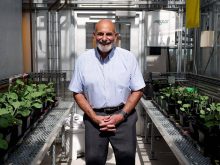With the development of 3D printing, the age of Star Trek replicators has arrived.
For master’s student Rhea Thomas Thommana and PhD student Kashika Sethi, food replication is on the horizon as well.
Thomas Thommana and Sethi were at Ag in Motion this week with a 3D printer designed to incorporate plant-based ingredients into food, part of ongoing research by University of Saskatchewan scientists Martin Reaney and Michael Nickerson.
Read Also

Claas Axion 9.450 tractor wins ‘Tractor of the Year’ at Agritechnica 2025
On opening day of Agritechnica 2025, Claas’ Axion 9.450 Terra Trac tractor was awarded ‘Tractor of the Year’ for 2026 in the HighPower category.
3D-printed food already exists. However, through the food sciences program at the University of Saskatchewan, Thomas Thommana and Sethi are building recipes that could mean plant-based materials specifically designed for a 3D printer.
“We’re still trying to figure out those concentrations to make it shelf-stable and also maybe in the future we could try dehydrating them, making it into a powder,” said Thomas Thommana.
The end result will be nutrient-rich and edible final products with implications in the healthcare field. The pea protein slurry they had on display was just a starting point, containing pregelatinized starch, canola oil and water.
“This particular slurry is basically made for the patients with dysphagia who have difficulty swallowing,” Sethi said.
The benefits of a 3D printer are that the slurry can be made into different shapes, texture, colours and tastes to make them palatable, to adults and even to children who need a nutritional boost.
Finding the right consistency also means finding a way to adjust the ingredients to fit different nutritional needs, said Thomas Thommana, as this research could mean tailor-making hospital foods to fit the needs of individual patients.
“People who actually have dietary restrictions can actually consume these things because these are made out of basic compounds that are safe for everybody,” she said.
Finding the right moisture content, right protein source and right composition of other ingredients has been the challenge. While a pea protein was on display at the University of Saskatchewan booth, Thomas Thommana said they are working with fava beans, canola, different oilseeds and other beans to see which one would work the best.
With a three-minute printing time, there will be a level of convenience in their 3D-printed food recipes, especially as 3D printers become more popular. If global research into 3D-printable food gets to the point where the packets can be sold like a cake mix, it could be as simple as putting the wet and dry ingredients together, said Thomas Thommana.
“We basically put it in the 3D printer and then we get high-protein-content, nutritious food out of it in the shape and size that we need.”
For Thomas Thommana and Sethi, this future of everyday food replication is more than just something out of science fiction, but the end goal of their research.
— Becky Zimmer reports for Glacier FarmMedia.














